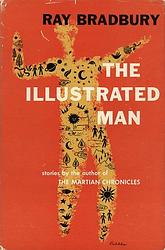The Illustrated Man by Ray Bradbury
"The Illustrated Man" is a collection of eighteen science fiction short stories that revolve around the mysterious figure of the illustrated man, whose body is covered in moving tattoos that predict the future. Each story explores themes of technology, humanity, and the consequences of our actions, taking readers on a thought-provoking journey through dystopian worlds, alien encounters, and the depths of human imagination. With vivid imagery and compelling narratives, the book delves into the complexities of human nature and the potential dangers of our own creations.
The 1945th greatest book of all time
Ranking Details:
Our ranking system awards points to books based on their appearance and position on curated lists. Here's how it works:
Unranked Lists: For lists without specific rankings, each book receives points equivalent to the list's weight. This approach recognizes the book's inclusion on prestigious lists.
Ranked Lists: Books on ranked lists receive points in two ways:
- Base Points: Initially, every book is awarded points equal to the list's weight, acknowledging its significance.
- Bonus Points: Additionally, books earn bonus points based on their ranking. The total bonus pool, equal to 100% of the list's weight, is distributed among the books, with higher-ranked books receiving more points.
Exponential Distribution: The distribution of bonus points follows an exponential model. This means the top-ranked book (#1) receives significantly more bonus points than those further down the list (e.g., #100). Our algorithm ensures that higher placements are rewarded more generously, reflecting the achievement of a top rank on any given list.
This scoring system ensures that each book's ranking reflects both its presence on multiple lists and its positions within those lists, providing a comprehensive measure of its acclaim and popularity.
Total Points: 192
Since this book was first published in 1951, there is a penalty of 0%. The age adjusted score is 192.0.
This is to prevent newer books from reaching super high on the ranked list of the greatest books of all time. The greatest books should also stand the test of time.
- score: 90 -- Our Users' Favorite Books of All Time (Weight: 90)
- score: 54 -- Top 100 Science-Fiction, Fantasy Books (Weight: 54)
- score: 27 -- The 100 Best Science Fiction Books of All Time (Weight: 27)
- score: 21 -- Top 200 Science Fiction Books (Pre-2000) (Weight: 21)

